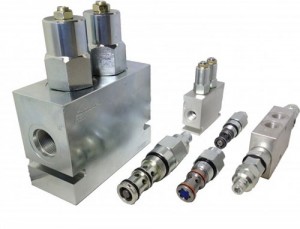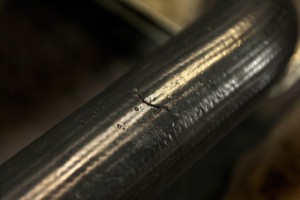
What does it mean to be safe with hydraulics? Hydraulics is just a form of force transfer, and is often not unique to the mechanical systems. For example, many hydraulic operations can be achieved with drives, gears, belts or electric motors. Safe hydraulics involves the consideration of a safe machine, first and foremost, and this is regardless of the form of motivation.
The two most critical considerations in hydraulic safety are with control of flow and pressure. Safe control of loads being manipulated by hydraulics is often primary. However, the safe containment of pressurized fluid often means loads are also stable, as a catastrophic leak of fluid could cause a failure of the system to control the load.
Safe control of a hydraulic load involves ensuring fluid is accurately metered. The potential for pressure and/or load-induced pressure to impart energy into oil is high. As such, the oil wants to give up that energy to the ambient surroundings, and is prevented from doing so by only the integrity of the components and conduits of the hydraulic system. The pressure either wants to escape past flow control or directional valves, or it attempts to exit to atmosphere through seals or plumbing failure points.
When fluid is well controlled through some sort of metering device, such as a flow control, counterbalance or proportional valve, the actuators and loads are prevented from running away. For example, when a cylinder is installed rod down, and loads are typically in tension, it is often installed with a meter-out configuration to prevent the load from running away with the cylinder. Although it is a safe method to prevent a runaway load, rod-side pressure intensification can be a risk. If intensification blows out piston seals, then the load can drop regardless, which is counterproductive to the meter out philosophy.
To avoid the pitfalls of metering out, a counterbalance valve can be used instead. The counterbalance valve is considered a pressure valve, but in reality, it controls the speed of an actuator. Without going into too much detail, these valves ensure a cylinder will only move as rapidly as pump flow is dictating, regardless of load-induced pressure or intensification. If a pilot signal is not seen from the opposite work port, the valve remains shut, preventing the load from dropping. Often mounted directly to the cylinder work port, the counterbalance valve also prevents dropping loads when hose or tube failures occur.

A leak in the cylinder hose or tube can also cause catastrophic failure and personal harm. When fluid is free to exit the actuator at a broken conduit, it can no longer hold a load up. The counterbalance valve prevents the load from dropping should there be a conduit failure. A pilot-operated check valve will provide the same safety function of a counterbalance valve, but is designed for static load-holding. It will hold a load indefinitely, but is not as smooth at controlling load-induced movement as the latter valve is.
Pressure is the very essence of a hydraulic system, and it is required to provide the force density which makes a hydraulic system so effective. But pressure can easily rise through intensification, load spikes, “water-hammer,” and thermal expansion, to name a few. If pressure isn’t controlled and limited, components can fail, seals can give way and either example can render a machine unsafe. For this reason, hydraulics uses many types of pressure control valves.
Relief valves are used to limit pressure, preventing damage and limiting power requirements. A relief valve is often just to control main system pressure, or isolated sub-circuits. Some circumstances require sub-circuits to operate at different pressures than others, and the pressure-reducing valve can achieve this. It limits pressure downstream of itself, and in some cases, can be a reducing-relieving valve as well. This type of valve can control downstream pressure spikes or thermal expansion, where heated fluid increases in pressure. Some hydraulic systems can use a combination of various pressure valves to ensure circuit pressure is safely limited at every part of the machine.
So by controlling both pressure and flow in a hydraulic system, best practices of safety can be observed. A machine failure is unsafe in the best scenarios, so ensuring a hydraulic circuit is designed for safety will prevent injury to operators.


I had a hose burst on me several years ago when I first started working with hydraulics. I never really want to experience anything like that again, so I’m always looking for ways to make sure my systems are running the best they can. In my experience, it really has made a big difference to check the little things often (not just hydraulics), and I’ve had little problems here and there, but still haven’t had another hose burst on me yet. Thanks for your suggestions!